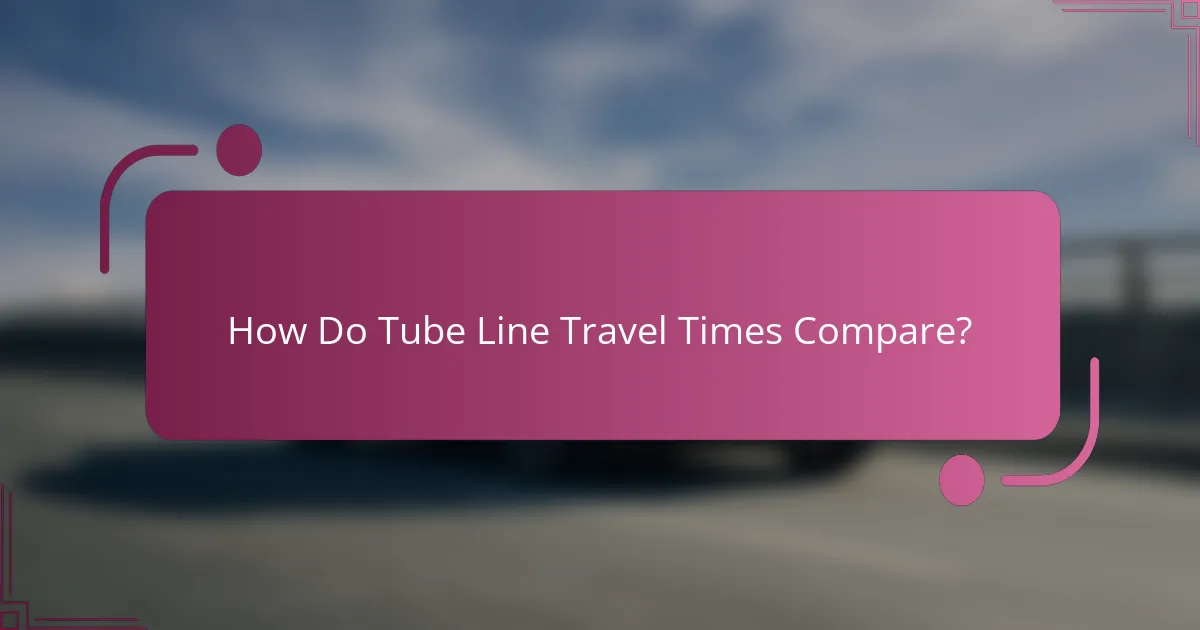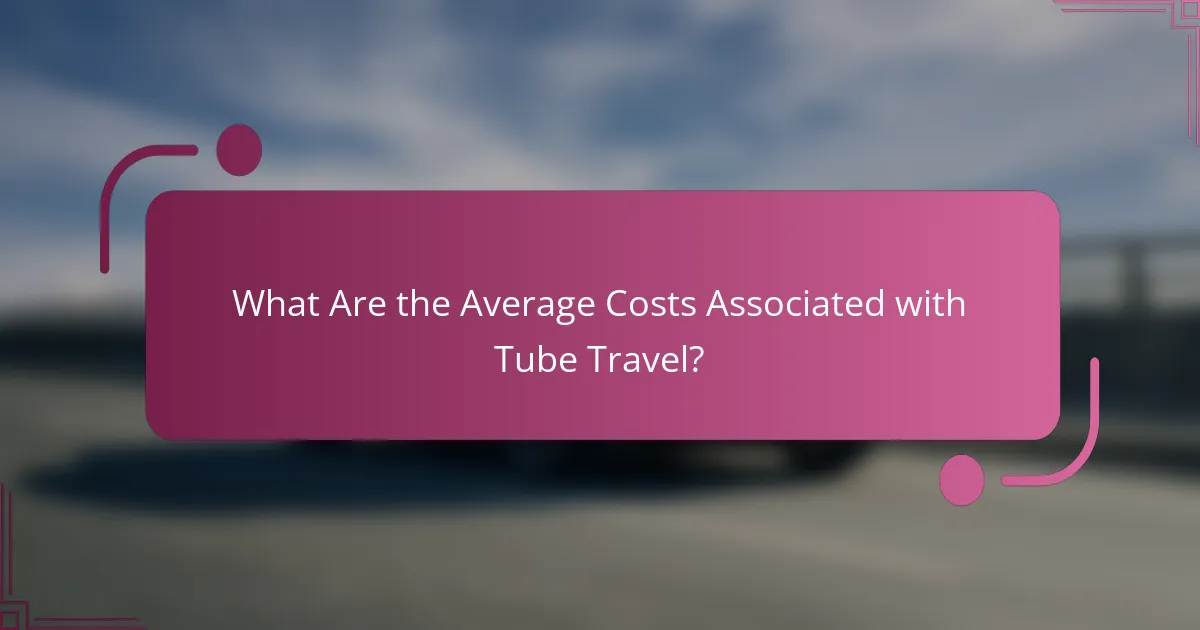Travel times on London Tube lines can differ greatly based on the specific line and route chosen. Typically, journeys within central London range from 15 to 30 minutes, influenced by factors such as distance, number of stops, and line efficiency. By understanding these variations, commuters can make informed decisions to optimize their travel experience.

What Are the Travel Times for Tube Lines in London?
The travel times for Tube lines in London vary significantly depending on the line and the specific route taken. Generally, most journeys within central London take between 15 to 30 minutes, with some lines offering faster connections than others.
Central Line travel time
The Central Line is one of the busiest lines in London, connecting the west and east of the city. Travel times on the Central Line typically range from 15 to 25 minutes for journeys between major stations like Oxford Circus and Liverpool Street.
When planning your trip, consider peak hours, as delays can occur due to high passenger volumes. It’s advisable to check real-time updates for any disruptions that may affect your travel time.
Piccadilly Line travel time
The Piccadilly Line runs from Heathrow Airport to Cockfosters, making it a popular choice for travelers. Average travel times on this line can range from 30 to 40 minutes for longer journeys, such as from Heathrow to central London.
For shorter trips within the city, expect travel times of around 15 to 25 minutes. Always check for service updates, especially during weekends when maintenance work may affect schedules.
District Line travel time
The District Line serves a wide area, including key destinations like Wimbledon and Tower Hill. Travel times can vary greatly, typically between 20 to 35 minutes depending on the distance and time of day.
Keep in mind that some District Line trains may run slower due to frequent stops. It’s beneficial to plan your journey in advance, especially during peak hours when trains can be crowded.
Jubilee Line travel time
The Jubilee Line is known for its speed and modern trains, connecting key areas like Stratford and Westminster. Travel times on the Jubilee Line are generally efficient, averaging around 15 to 25 minutes for central routes.
This line is particularly useful for quick transfers between major attractions. However, be aware of potential delays during busy periods, so checking live updates can enhance your travel experience.
Circle Line travel time
The Circle Line offers a circular route around central London, making it convenient for short trips. Travel times typically range from 10 to 20 minutes, depending on your starting and ending stations.
While the Circle Line is useful for connecting to various other lines, it can be slower during peak hours due to its frequent stops. Consider using alternative routes if you’re in a hurry, especially during rush hour.

How Do Tube Line Travel Times Compare?
Travel times on London Tube lines vary based on factors like distance, stops, and line efficiency. Understanding these differences can help commuters choose the best routes for their journeys.
Comparison of Central and Piccadilly Lines
The Central and Piccadilly Lines serve different areas of London but have overlapping sections. The Central Line typically offers faster travel times due to fewer stops in central zones, averaging around 2-3 minutes between stations during peak hours.
In contrast, the Piccadilly Line, while connecting key locations like Heathrow Airport, may take longer due to more frequent stops and longer distances between some stations. Commuters should consider their destination when choosing between these lines.
Comparison of District and Jubilee Lines
The District and Jubilee Lines provide essential connections across London, with the Jubilee Line often being faster due to its more modern infrastructure and fewer stops in central areas. Travel times on the Jubilee Line can be around 5-10 minutes quicker for similar routes.
However, the District Line offers more local stops, which can be beneficial for passengers needing access to specific neighborhoods. Depending on the time of day, delays can affect both lines, so checking real-time updates is advisable.
Comparison of Circle and Central Lines
The Circle Line is designed for circular travel around central London, while the Central Line runs straight through the city. Travel times on the Circle Line can be longer, averaging 10-15 minutes for a full loop, compared to the Central Line’s quicker 5-10 minutes between major hubs.
For commuters, the choice between these lines often depends on their starting point and destination. The Central Line is generally preferred for speed, while the Circle Line may be more convenient for accessing multiple attractions in a single trip.

What Factors Affect Tube Line Travel Times?
Tube line travel times can vary significantly due to several key factors, including the time of day, operational disruptions, and weather conditions. Understanding these elements can help commuters plan their journeys more effectively.
Peak vs. off-peak hours
Travel times on Tube lines are generally longer during peak hours, which typically occur on weekdays from around 7:30 AM to 9:30 AM and 5:00 PM to 7:00 PM. During these times, trains are more crowded, and delays can occur due to the high volume of passengers.
In contrast, off-peak hours, such as mid-morning and late evening, usually offer faster travel times. Commuters can expect shorter wait times and less crowded trains, making their journeys more efficient.
Line disruptions and maintenance
Scheduled maintenance and unexpected disruptions can significantly impact travel times on Tube lines. Maintenance work often occurs during off-peak hours, but it can still lead to delays or altered services, particularly on weekends.
Additionally, disruptions caused by incidents such as signal failures or accidents can lead to extended delays. Passengers should check real-time updates on the Transport for London (TfL) website or app before traveling to avoid unexpected wait times.
Weather conditions impact
Weather can also affect Tube line travel times. Heavy rain, snow, or extreme heat can lead to slower train speeds and increased delays. For example, snow can cause signal issues and track problems, while heat can lead to speed restrictions to ensure safety.
Commuters should monitor weather forecasts and consider potential impacts on their travel plans, especially during adverse conditions. Allowing extra time for journeys during such weather can help mitigate the effects of delays.

How to Optimize Your Tube Travel Time?
To optimize your Tube travel time, consider using real-time travel apps, selecting alternative routes, and timing your travel effectively. These strategies can help you navigate London’s Tube system more efficiently, reducing delays and improving your overall journey experience.
Using real-time travel apps
Real-time travel apps provide live updates on Tube schedules, delays, and service disruptions. By using apps like Citymapper or TfL Go, you can receive alerts about any changes that may affect your route, allowing you to adjust your travel plans accordingly.
These apps often include features such as estimated arrival times and alternative route suggestions, which can save you significant travel time. Make it a habit to check these apps before you start your journey to stay informed and make better decisions.
Choosing alternative routes
Sometimes, taking a less direct route can actually save you time, especially during peak hours. Consider using different lines or stations that may have fewer passengers or less frequent delays. For instance, if the Central Line is congested, the Hammersmith & City Line might offer a quicker alternative.
Experimenting with various routes can reveal hidden shortcuts and less crowded options. Keep in mind that while some routes may take longer in distance, they can significantly reduce your overall travel time during busy periods.
Timing your travel
Timing your travel can greatly impact your Tube experience. Traveling during off-peak hours, typically mid-morning or early afternoon, can lead to shorter wait times and less crowded trains. Avoiding rush hours can make your journey more comfortable and efficient.
Additionally, if you have flexibility in your schedule, consider planning your trips around known events or disruptions. Checking the TfL website for planned engineering works or events that may affect service can help you choose the best times to travel.

What Are the Average Costs Associated with Tube Travel?
The average costs associated with Tube travel in London can vary based on the payment method and the zones traveled. Generally, fares range from a few pounds for short trips to higher amounts for longer journeys across multiple zones.
Oyster card pricing
Using an Oyster card is one of the most cost-effective ways to travel on the Tube. Fares are typically lower than those paid with cash or contactless cards, with single journeys starting around £2.40 for travel within central London zones. Daily caps apply, meaning once you reach a certain spending threshold, any additional travel within that day is free.
For regular commuters, Oyster cards offer significant savings, especially with weekly or monthly travel cards available. It’s advisable to register your Oyster card online to protect your balance in case of loss or theft.
Contactless payment options
Contactless payment options, such as debit and credit cards, are widely accepted on the Tube, providing convenience for travelers. The fares are the same as those for Oyster cards, starting at approximately £2.40 for single journeys. Like Oyster, contactless payments also benefit from daily caps.
Keep in mind that some banks may charge foreign transaction fees, so check with your bank before using a non-UK card. Additionally, ensure your card is enabled for contactless payments to avoid any issues while traveling.
